
The strange-horned chameleon, also known as Rwenzori plate-nosed chameleon or single welded-horn chameleon, is a species of chameleon. It is native to the rainforests of the Ruwenzori Mountains of western Uganda and eastern Democratic Republic of the Congo.
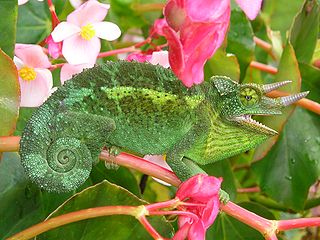
Jackson's chameleon, also known commonly as Jackson's horned chameleon, the three-horned chameleon, and the Kikuyu three-horned chameleon, is a species of chameleon, a lizard in the family Chamaeleonidae. The species is native to East Africa, and introduced to Hawaii, Florida, and California. There are three recognized subspecies.
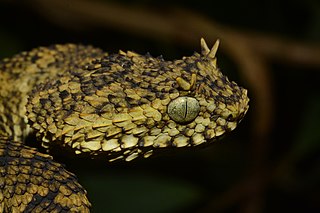
Atheris ceratophora is a venomous viper species endemic to a few mountain ranges in Tanzania. This used to be the only horned, arboreal viper known from Africa, until the discovery in 2011 of Atheris matildae, also found in Tanzania. No subspecies are currently recognized.

Parson's chameleon is a species of chameleon in the family Chamaeleonidae that is endemic to eastern and northern Madagascar. It is found from lowlands to an altitude of 1,195 m (3,920 ft) above sea level and mainly inhabits humid primary forest, but can also occur in disturbed habitats with trees. For a chameleon, it is very large, long-lived and slow-reproducing.
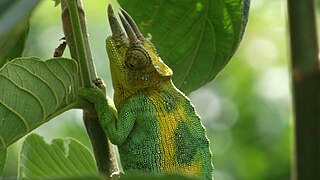
Trioceros johnstoni, known commonly as Johnston's chameleon, Johnston's three-horned chameleon, and the Ruwenzori three-horned chameleon, is a species of chameleon, a lizard in the family Chamaeleonidae. The species is endemic to highlands in the Albertine Rift in central Africa. It reaches up to 30 cm (12 in) in total length. Only the adult male has three horns. The female is hornless.

Trioceros melleri, with the common names Meller's chameleon and giant one-horned chameleon, is the largest species of chameleon from the African mainland.

The coarse chameleon, also known as the rudis chameleon, Ruwenzori side-striped chameleon or the Rwenzori bearded chameleon, is a chameleon from western Uganda, Rwanda, Burundi, and eastern DR Congo. Contrary to common belief, this species does not inhabit Mount Meru, Tanzania. Tanzania chameleons called T. rudis are in fact T. sternfeldi.

The West Usambara two-horned chameleon or West Usambara blade-horned chameleon is a species of chameleon endemic to the West Usambara Mountains of Tanzania. Until 2008, it was generally confused with Fischer's chameleon, which is not found in the Usambara Mountains. None of its close relatives occur in the same range as K. multituberculata, but K. matschiei and K. vosseleri are restricted to the East Usambaras.
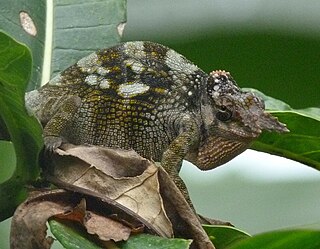
Kinyongia tavetana, the Kilimanjaro two-horned chameleon or Kilimanjaro blade-horned chameleon, is a species of chameleon in the genus Kinyongia. It is native to forests, woodlands, well-wooded gardens and plantations in the highlands of southern Kenya and northern Tanzania. Its type locality is Mount Kilimanjaro, but it is also known from Chyulu Hills and Mount Meru to the Pare Mountains.
The spiny-flanked chameleon, also known as the spiny-sided chameleon, is a species of chameleon endemic to Tanzania. It was first described in 1932 by Arthur Loveridge.

The crested chameleon, also known as the sail backed chameleon, is a species of chameleon native to forests and semi-open wooded habitats in Central Africa.

The Cameroon sailfin chameleon or Cameroon two-horned mountain chameleon is a species of chameleon endemic to Cameroon. It has a very unusual appearance.
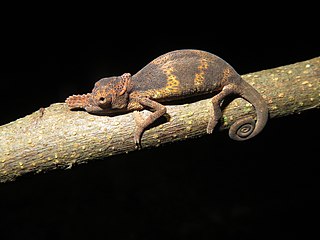
Kinyongia tenuis, also known as the Usambara soft-horned chameleon, Usambara flap-nosed chameleon and Matschie's dwarf chameleon, is a fairly small species of chameleon from Kenya and Tanzania.

Kinyongia matschiei, common name giant monkey-tailed east Usambara two-horned chameleon, giant east Usambara blade-horned chameleon, and Matschie's two-horned chameleon, is a species of chameleon from the East Usambara Mountains in Tanzania. It was formerly confused with K. fischeri, which is not found in the range of K. matschiei.

Owen's chameleon, also commonly known as Owen's three-horned chameleon, is a species of lizard in the family Chamaeleonidae. The species is native to forests in central Africa. Named after British naval officer and explorer William Fitzwilliam Owen, it was first described in 1831 by the naturalist John Edward Gray, and is the type species of the genus Trioceros.

Kinyongia boehmei, the Taita blade-horned chameleon, Böhme's two-horned chameleon and Dwarf fischer's chameleon, is species of chameleon, a lizard in the family Chamaeleonidae, found only in the Taita Hills of southeastern Kenya. It is the smallest species in the East African "two-horned chameleon" group and until 2008 it was generally considered a part of K. tavetana.

Kinyongia vosseleri, also known commonly as the Usambara two-horned chameleon and Vosseler's blade-horned chameleon, is an endangered species of lizard in the family Chamaeleonidae. The species is endemic to Tanzania.

The four-horned chameleon is a species of chameleon, a lizard in the family Chamaeleonidae. The species is native to highland areas in western Cameroon and southeastern Nigeria.
Trioceros fuelleborni, also known commonly as the flapjack chameleon, the Ngosi Volcano chameleon, and the Poroto three-horned chameleon, is a species of lizard in the family Chamaeleonidae. The species is endemic to Tanzania.

Trioceros werneri, the Wemer's chameleon or Wemer's three-horned chameleon, is a species of chameleon that is endemic to forests and nearby gardens at altitudes of 1,700–2,600 m (5,600–8,500 ft) in the Eastern Arc Mountains of Tanzania. The adult male has three distinct "horns", whereas the female has no or only a single short horn on the nose. Like many Trioceros species of highlands, the female T. werneri does not lay eggs, but instead gives birth to live young, typically 15–20 at a time.




















